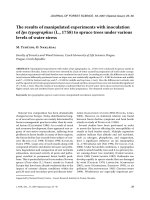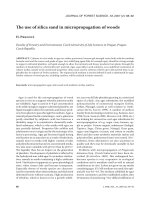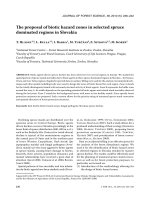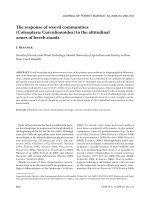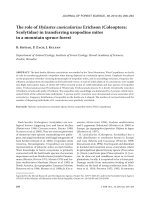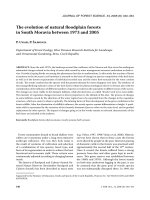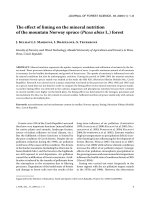Báo cáo lâm nghiệp: "The results of manipulated experiments with inoculation of Ips typographus (L., 1758) to spruce trees under various levels" potx
Bạn đang xem bản rút gọn của tài liệu. Xem và tải ngay bản đầy đủ của tài liệu tại đây (245.1 KB, 6 trang )
J. FOR. SCI., 53, 2007 (Special Issue): 25–30 25
JOURNAL OF FOREST SCIENCE, 53, 2007 (Special Issue): 25–30
e results of manipulated experiments with inoculation
of Ips typographus (L., 1758) to spruce trees under various
levels of water stress
M. T, O. N
Faculty of Forestry and Wood Sciences, Czech University of Life Sciences Prague,
Prague, Czech Republic
ABSTRACT: Manipulated experiments with males of Ips typographus (L., 1758) were conducted in spruce stands in
north-western Slovakia. Some of trees were stressed by a lack of water caused by preparation of roofs under canopy.
Inoculation experiments with bark beetles were conducted on such trees. According to results, the differences in attack
rates between differently positioned trees on slope were not statistically significant (P = 0.389 for bottom and middle
and P = 0.924 for bottom and top, and P = 0.530 for middle and top trees, t-test). Also the differences in attacks rate
and the speed of entry holes preparation between more stressed and less-stressed trees were not statistically significant
(P = 0.321, t-test). us the results of inoculation confirmed that low level of water stress does not lead necessarily to
higher attack rate and (neither) faster speed of entry holes preparation. e obtained results are discussed.
Keywords: Ips typographus; spruce; water stress; manipulated inoculation experiments
Supported by National Forest Centre – Forest Research Institute in Zvolen, Slovakia.
Natural tree composition has been dramatically
changed across Europe. Today, distributional rang-
es of several tree species are mainly determined by
former management practices rather than by natu-
ral factors (E 1986). As a result of social
and economy development, there appeared vast re-
gions of non-native monocultures, suffering from
problems in forest health. In many of these regions,
the forest decline has recently been subject of con-
cern (B et al. 1988; F 1990; K,
I 1995). Large area of such stands along with
compound of biotic and abiotic stressors (air pollu-
tion, degradation and compaction of soil, nutrients
exhaustion, increased activity of pests and patho-
gens) resulted to permanent forest health prob-
lems. is is particularly true for secondary Norway
spruce (Picea abies [L.] Karst.) stands in Central
Europe that have been already weakened due to the
impact of extreme climate conditions within the
past 20 years and secondary pest and disease infes-
tation (J, C 2002; H, L
2002). However, no statistical relation was found
between forest decline symptoms and bark beetle
attacks in study of P et al. (1996).
Several studies have been performed in order
to assess the factors affecting the susceptibility of
stands to bark beetles attack. Multiple regression
analyses indicate that altitude and soil nutrients,
such as nitrogen, phosphorus, and magnesium,
have a significant influence on Ips typographus
(L., 1758) attacks rate (N 1994; D et al.
2000). Under favourable conditions, I. typographus
is able to attack healthy trees and it is a primary fac-
tor causing direct tree mortality (C,
H 1980; C 1989). Outbreaks can
develop rapidly in spruce stands that are damaged
by wind (C 1978; L, S
2001), snow (S, E 1993), or air
pollution (B 1985; C
1989). Windstorms are especially important pre-
26 J. FOR. SCI., 53, 2007 (Special Issue): 25–30
cursors to outbreaks because they quickly provide
large quantities of breeding material in the form of
broken or fallen stems (C 1981; G et
al. 2000; M et al. 2001). Many evidences
exist about the high susceptibility of the trees to
bark beetles (mainly I. typographus L.) after ex-
posure to the sun subsequently after opening the
canopy (L, S 1996; J 1998).
ere are also indications that trees stressed by
drought (G 1998; G et al. 2002)
are more infested by bark beetles, but quantitative
study of this relation is not easy.
us, the main goal of this paper is to analyze the
behaviour of bark beetles on trees under various
regime of water stress in declining spruce mono-
cultures. Within the frame of which we focus on:
– analysis of I. typographus attacks rate on trees
with various position on slope and on stressed
versus unstressed trees;
– analysis of I. typographus attacks rate and speed
of boring on more stressed versus less stressed
trees.
METHODOLOGY
e effect of water stress on the attack of I. ty-
pographus males has been studied by two experi-
mental designs:
– on the trees stressed by their various position on
slope (bottom, middle part, top of slope),
– on the trees stressed versus not stressed by elimi-
nation of precipitation.
Preparation of I. typographus males
to experiments
Acquisition of wild individuals. To collect
adults of I. typographus, 5 pheromone traps were
installed in central Slovakia in spring, which were
baited by pheromone dispensers. In the peak of
spring flight, the traps were cleaned each hour and
non-damaged individuals were collected. ese in-
dividuals were put into refrigerator into wet envi-
ronment and later transported to lab. After several
days, the number of individuals was enough high to
establish artificial rearing.
Laboratory rearing of I. typographus. e rear-
ing cages were used for breeding of beetles on
spruce bolts. Bolts were prepared from non-infested
spruce logs 1 month prior breeding started. Selected
non-damaged individuals were tested on motion
and than released to rearing cages. ey mated and
established new generation. e breeding was con-
ducted in natural temperature and light conditions
to have adults at the end of June. Bolts were watered
and treated by anti-fungal solution if necessary.
Emerged individuals were taken away each day.
Storing the emerged individuals. e emer-
gence of individuals usually takes longer time. e
manipulated experiments requested several hun-
dred individuals and thus fresh adults were stored
in refrigerator in specific conditions where they
were able to survive several days.
Sexing the adults for experiments. After estab-
lishment of water stress experiments, the stored
adults were sexed, because only males were tested
in manipulated experiments. Sexing was done ac-
cording a paper of S and C
(1981). According to this paper, males have bigger
frontal projection and less dense hairs cover on
front. Sexed males were stored again in refrigera-
tor. Prior experiments, they were transported in the
field refrigerator, released for 1–2 hours for adapta-
tion and than used into experiments.
Establishment of experiments. Selected males
were released to small ampoules (Fig. 1), which
Fig. 1. One-way choice experiment established
on stressed tree at August 18
th
2006 (Kysuce
– Šadibolovci)
J. FOR. SCI., 53, 2007 (Special Issue): 25–30 27
were fixed to trees without possibility for males to
escape = 1-way choice experimental design. Bored
dust was collected and the frequency of attack and
the depth of entry holes were measured. Simulta-
neously, the water regime of each tree was recorded
by sap-flow meter. Ten males were inoculated at
each of 15 trees. Prior maternal chamber was start-
ed to be prepared, the beetles were removed from
the trees and damage was treated by resin.
“One way choice” experiments were conducted
in 3 various days when parameters of water stress
were predicted to be as different (July 19
th
and 27
th
,
August 18
th
2006). Prior these experiments, the
preliminary tests of all parameters were done at the
beginning of July (e.g. to eliminate complete forma-
tion of entry hole and start attractant production).
e real experiments were conducted on 2 dif-
ferent sites situated 1 km from each other. Site
1 consisted of 3A, B, C triples of trees (bottom
= n. 3, middle = n. 4 and top = n. 5A, B, C of slope)
where water regime was evaluated. Site 2 consisted
of 2 triples of trees. Each tree in the 1
st
triple was
manipulated by plastic roofs, which prevented pre-
cipitation to enter soil under roof (labeled in Tables
1 and 2 as S = with roof), another one was without
roof (B = without roof). e results of frequency
and the depth of entry holes (stressed versus un-
stressed) were tested by sign test and t-test respec-
tively. e results of this experiment were subse-
quently compared to data which were obtained by
sap-flow meter. Because the experimental design of
sap-flow meters, the data obtained were not con-
tinuous and we were only able to evaluate quali-
tative parameters of water stress (we were able to
evaluate that lower stress was on non-manipulated
trees than on trees with roofs).
RESULTS AND DISCUSSION
Preliminary experiments have been conduct-
ed at the beginning of July 2007 at research area
Šadibolovci. It was necessary to evaluate the speed
of entry hole preparation (Fig. 1), to prevent estab-
lishment of mating chamber, attractant production
and infestation of experimental tree by additional
individuals. Experimental trees were used by sev-
eral research groups and it was highly needed that
trees remained on the place whole season. Briefly:
10 males were released to each of experimental
trees and the speed of boring was estimated each
2 hours. One tree was in shadow and one was on
direct sunlight. Males started with boring 2 hours
after inoculation and 6 hours later were fully bored
(but they did not start to prepare mating chamber).
us, the maximum span of subsequent inocula-
tion experiments was stated to be 6–8 hours.
Bottom triple (trees 3), was attacked by lower
number of beetles as medium (trees 4) and top
(trees 5) triples (Table 1). e sign test suggested
that these differences were statistically not sig-
Table 1. Number of entry holes produced by males into individual trees
Tree 1
st
checking 2
nd
checking Tree 1
st
checking 2
nd
checking Tree 1
st
checking 2
nd
checking
July 19
th
2006
5A 0 0 4A 1 3 3A 0 0
5B 1 3 4B 1 1 3B 1 2
5C 1 3 4C 0 2 3C 0 1
Total 2 6 Total 2 6 Total 1 3
July 27
th
2006
1S 0 1 1B 2 2
2S 0 2 2B 0 2
3S 4 5 3B 1 3
Total 4 8 Total 3 7
August 18
th
2006
1S 2 2 1B 0 1
2S 0 0 2B 2 4
3S 1 1 3B 2 4
Total 3 3 Total 4 9
28 J. FOR. SCI., 53, 2007 (Special Issue): 25–30
nificant (P = 0.577 for 3–5 and 4–5, P = 0.000 for
4–5 in case 1
st
checking; P = 1.000 for 3–5 and
4–5, P = 0.000 for 4–5 in case 2
nd
checking). Ta-
ble 2 presents average depth of entry holes calcu-
lated from 10 individuals on each tree in mm. e
1
st
checking was done after 2 hours, the 2
nd
one
after additional 4–5 hours, when the most active
males were able completely bored into the tree.
Statistical significance of differences in average
depth of entry holes (Table 2) was not confirmed
on the base of data from the 1
st
checking. e dif-
ferences between trees 3 and 4 were not significant
(P = 0.573, t-test). e results were same between
3 and 5 (P = 0.573, t-test) and between 4 and 5
(P = 1.000, t-test). Test showed similar results also
after the 2
nd
checking (6 hours later – P = 0.389 for
3 and 4 and P = 0.924 for 3 and 5, and P = 0.530 for
4 and 5).
e end of July 2006 was characterized by rela-
tive lack of precipitation but differences between
the number of individuals bored into stressed and
control trees were not statistically significant (P =
0.378, sign test for 1
st
checking; P = 0.258, sign test
for 2
nd
checking). e experiments were time-con-
suming and thus, only 10 individuals were inoculat-
ed to each tree which represents a low attack rate.
It would be necessary to inoculate higher number
of individuals to simulate mass attack in the future.
Experiments above were conducted on the base of
trees and this is not optimal place for attack. Ad-
ditional experiments might be conducted on place
of the most frequent attack – below the beginning
of the green canopy.
Also average depth of entry holes in this experi-
ment was not significantly different for the 1
st
(P =
0.423, t-test) and also for the 2
nd
(P = 0.321, t-test)
checking.
After higher amount of precipitation and im-
provement of water regime in August 2006, the
frequency of attacks increased on controlled trees
which were not stressed by manipulated drought.
We expected opposite results, but similar situa-
tions are also known in literature when R et
al. (1995) suggested that lower level of water stress
mobilize the defence mechanism of stressed trees
what subsequently leads to an increase of resin
production. Simulation of such attack may lead to
a decrease of frequency number of entry holes in
manipulated experiments on stressed trees.
e same situation was observed on the same
trees also in experiments in August 18
th
. Statistical
significance of differences was not confirmed either
for the 1
st
(P = 0.557, t-test), nor for the 2
nd
check-
ing (P = 0.291, t-test).
Experiments were conducted in spruce stands
which are characterized by radial increment almost
equal to 0, which suggest that assimilatory appa-
ratus of trees have not worked well for the whole
experimental time. Partial explanation of such phe-
nomena gives measurement of water regime on the
same trees, which suggested some level of water
stress in July 2006 (higher) and in August (lower).
Table 2. Average depth of entry holes on experimental trees
Tree 1
st
checking 2
nd
checking Tree 1
st
checking 2
nd
checking Tree 1
st
checking 2
nd
checking
July 19
th
2006
5A 0 0 4A 0.1 0.8 3A 0 0
5B 0.1 0.3 4B 0.1 0.7 3B 0.1 1.2
5C 0.1 0.9 4C 0 0.7 3C 0 0.1
Total 0.067 0.4 Total 0.067 0.733 Total 0.033 0.433
July 27
th
2006
1S 0 0.1 1B 0.1 0.5
2S 0 0.2 2B 0 0.9
3S 0.4 0.7 3B 0.1 0.6
Total 0.133 0.333 Total 0.067 0.667
August 18
th
2006
1S 0.2 0.5 1B 0 0.4
2S 0 0 2B 0.2 1
3S 0.05 1 3B 0.2 1.4
Total 0.083 0.5 Total 0.133 0.933
J. FOR. SCI., 53, 2007 (Special Issue): 25–30 29
e amount of precipitation in July was low and the
effect of this fact we observed via continual dry-
ing the trees in that time (with exception of several
days in the mid of July when precipitation was ob-
served). e beginning of August was quite differ-
ent when trees have not suffered by water stress.
Subsequently, the fall 2006 was dry (experiments
with beetles were not conducted that time).
Generally, it is possible to say that average depth
of entry holes was bigger on trees which were less
stressed by a lack of water. e exact mechanism of
these relationships between the water stress and the
increase of tree resistance up to some level is not
known yet (R et al. 1995). We can only specu-
late that water stress is predisposing factor only after
excess of some level, when defensive mechanism of
tree is not able to produce the necessary amount of
resin. Our results suggested that when trees suffer a
low level of stress, they are able to increase their re-
sistance and to be resistant longer time. In opposite,
trees which were stressed and stress diminished due
to late precipitation, became more attractive and
less resistant. However, these speculations need to
be confirmed by more extensive experiments.
CONCLUSIONS
e differences in attack rates and speed of entry
holes preparation between differently positioned
trees on slope were not statistically significant ac-
cording to results.
e results of manipulated experiments indicat-
ed, that frequency and speed of boring was similar
on more stressed versus less stressed trees during
hot and dry weather, but frequency and speed be-
came higher on less stressed trees in wet and colder
period later.
ese preliminary results suggested that the role
of water stress is complicated and it is necessary
to repeat manipulated experiments with higher
number of inoculated beetles and on different po-
sition on the trees (on stem under canopy).
Acknowledgements
We particularly thank to S R who
checked the English.
R efe re nc es
BALTENSWEILER W., 1985. Waldersterben: forest pests and
air pollution. Zeitschrift für Angewandte Entomologie,
99: 77–85.
BLANK L.B., ROBERTS T.M., SKEFFINGTON R.A., 1988.
New perspectives on forest decline. Nature, 336: 27–30.
CAPECKI Z., 1978. Badania nad owadami kambio- i ksylofa-
gicznymi rozwijającymi się w górskich lasach świerkowych
uszkodzonych przez wiatr i okiść. Prace Instytutu Badaw-
czego Leśnictwa, Nr. 563: 37–117.
CAPECKI Z., 1981. Zasady prognozowania zagrożenia oraz
ochrona górskich lasów świerkowych przed owadami na tle
szkód wyrządzanych przez huragany i okiść. Prace Instytutu
Badawczego Leśnictwa, Nr. 584: 3–44.
CHRISTIANSEN E., 1989. Bark beetles and air pollu-
tion. Meddelelser Norsk Institut for Skogforskning, 42:
101–107.
CHRISTIANSEN E., HUSE K.J., 1980. Infestation ability of
Ips typographus in Norway spruce, in relation to butt rot,
tree vitality and increment. Meddelelser Norsk Institut for
Skogforskning, 35: 473–482.
DUTILLEUL P., NEF L., FRIGON D., 2000. Assessment of
site characteristics as predictors of the vulnerability of
Norway spruce (Picea abies Karst.) stands to attack by
Ips typographus L. (Col., Scolytidae). Journal of Applied
Entomology, 124: 1–5.
ELLENBERG H., 1986. Vegetation Mitteleuropas mit den
Alpen. Stuttgart, Verlag Eugen Ulmer: 110.
FÜHRER E., 1990. Forest decline in Central Europe: Addi-
tional aspects of its cause. Forest Ecology and Management,
37: 249–257.
GÖTHLIN E., SCHROEDER L.M., LINDELÖW A., 2000.
Attacks by Ips typographus and Pityogenes chalcographus
on windthrown spruces (Picea abies) during the two years
following a storm felling. Scandinavian Journal of Forest
Research, 15: 542–549.
GRODZKI W., 1998. Wybrane objawy stresu w świerczynach
Sudetów Zachodnich w aspekcie oddziaływania czynni-
ków abiotycznych i skutków masowego pojawu wskaźnicy
modrzewianeczki Zeiraphera griseana Hb. (Lepidoptera:
Tortricidae). Prace Instytutu Badawczego Leśnictwa, Seria
A, Nr. 848: 127–155.
GRODZKI W., JAKUŠ R., SITKOVA Z., GAZDA M., 2002.
Ocena zagroźenia oraz postçepowanie ochronne w eko-
systemach leśnych Tatr objętych gradacjami owadów
kambiofagicznych. In: BOROWIEC W., KOTARBA A.,
KOWNACKI A., KRZAN Z., MIREK Z. (eds), Wspóczesne
przemiany środowiska przyrodniczego Tatrz. Zakopane,
PTPNoZ–TPN: 213–216.
HOLUŠA J., LIŠKA J., 2002. Hypotéza hynutí smrkových
porostů ve Slezsku (Česká republika). Zprávy lesnického
výzkumu, 47: 9–15.
JAKUŠ R., 1998. Types of bark beetle (Coleoptera: Scolytidae)
infestation in spruce forest stands affected by air pollution,
bark beetle outbreak and honey fungus (Armillaria mellea).
Anzeiger für Schädlingskunde, Pflanzen- und Umwelt-
schutz, 71: 41–49.
30 J. FOR. SCI., 53, 2007 (Special Issue): 25–30
JANKOVSKÝ L., CUDLÍN P., 2002. Dopad klimatické změny
na zdravotní stav smrkových porostů středohor. Lesnická
práce, 81: 106–109.
KANDLER O., INNES J.L., 1995. Air pollution and forest
decline in Central Europe. Environmental Pollution, 90:
171–180.
LINDELÖW A., SCHROEDER L.M., 2001. Attack dynamic
of the spruce bark beetle (Ips typographus L.) within and
outside unmanaged and managed spruce stands after a
stormfelling. In: KNÍŽEK M. et al. (eds), Methodology of
Forest Insect and Disease Survey in Central Europe. Pro-
ceedings of the IUFRO WP 7.03.10 Workshop, Busteni,
Romania. Brasov, IUFRO-ICAS: 68–71.
LOBINGER G., SKATULLA U., 1996. Untersuchungen zum
Einfluss von Sonnenlicht auf das Schwärmverhalten von
Borkenkäfern. Anzeiger für Schädlingskunde Pflanzen- und
Umweltschutz, 69: 183–185.
MIHALCIUC V., DANCI A., OLENICI N., VLADULEASA A.,
2001. Sanitary status of resinous stands from Romania and
the protection measures applied in the 1990–2000 period.
Journal of Forest Science, 47: 136–138.
NEF L., 1994. Estimation de la vulnerabilité de pessiers aux
attaques d’Ips typographus L. à partir de caractéristiques
stationelles. Silva Belgica, 101: 7–14.
PRIEN S., STÄHR F., KOST F., WITTIG T., 1996. Befallsdispo-
sition von Fichtenbeständen für Borkenkäfer bei Vorliegen
neuartiger Waldschäden im üringer Wald (Coleoptera:
Scolytidae). Entomologica Generalis, 21: 17–25.
REEVE J.D., AYRES M.P., LORIO P.L., 1995. Host suitability,
predation, and bark beetle population dynamics. In: CAP-
PACCINO N., PRICE P.W. (eds), Population Dynamics:
New Approaches and Synthesis. San Diego, Academic
Press: 339–357.
SCHLYTER F., CEDERHOLM I., 1981. Separation of the
sexes of living spruce bark beetles, Ips typographus (L.),
(Coleoptera: Scolytidae). Zeitschrift für Angewandte En-
tomologie, 92: 42–47.
SCHROEDER L.M., EIDMANN H.H., 1993. Attacks of bark-
and wood-boring Coleoptera on snow-broken conifers over
a two-year period. Scandinavian Journal of Forest Research,
8: 257–265.
Výsledky manipulovaných experimentů s inokulací Ips typographus (L., 1758)
na smrcích s rozdílnou úrovní vodního stresu
ABSTRAKT: Ve smrkových porostech na severozápadě Slovenska byly realizovány manipulované inokulační expe-
rimenty se samci Ips typographus (L., 1758). Modelové stromy byly stresovány nedostatkem vody připravenými
stříškami a na nich byly vedeny inokulační experimenty s lýkožroutem smrkovým. Na základě výsledků nebyly rozdíly
mezi napadením stromů s různou pozicí na svahu statisticky významné (P = 0,389 pro stromy na bázi a ve středu
svahu, P = 0,924 pro bázi a vrchol svahu a P = 0,530 pro střed a vrchol svahu, t-test). Rovněž rozdíly v napadení
a rychlosti vytváření závrtů mezi více a méně stresovanými stromy nebyly statisticky významné (
P = 0,321, t-test).
Výsledky inokulačních pokusů indikují, že mírná hodnota vodního stresu nevede zákonitě ani ke zvýšení napadení,
ani k rychlejšímu zavrtávaní samců do stromu. O získaných výsledcích se diskutuje.
Klíčová slova: Ips typographus; smrk; vodní stres; manipulované inokulační pokusy
Corresponding author:
Doc. Ing. M T, Ph.D., Česká zemědělská univerzita v Praze, Fakulta lesnická a dřevařská,
165 21 Praha 6-Suchdol, Česká republika
tel.: + 420 224 383 738, fax: + 420 224 383 739, e-mail: turcani@fld.czu.cz
